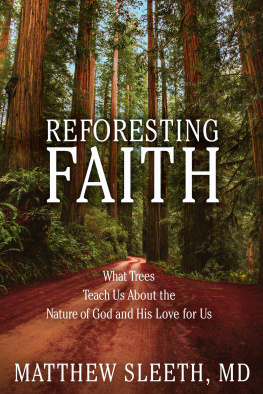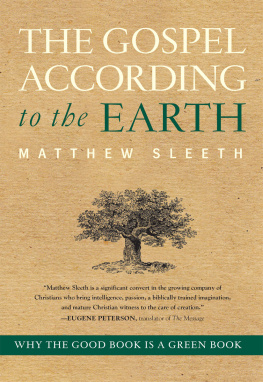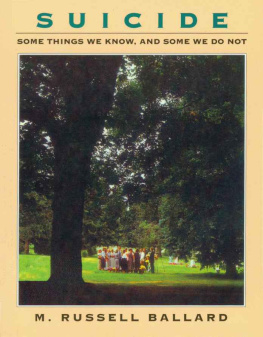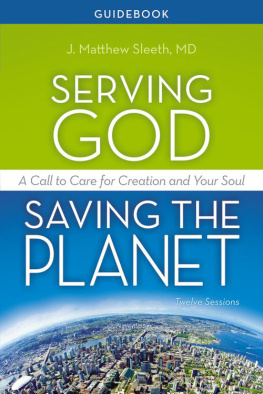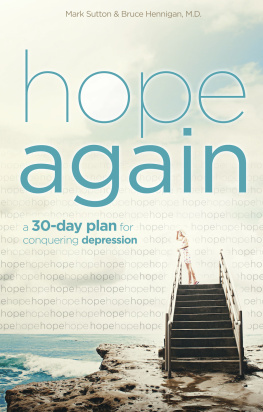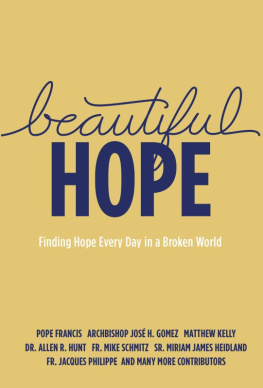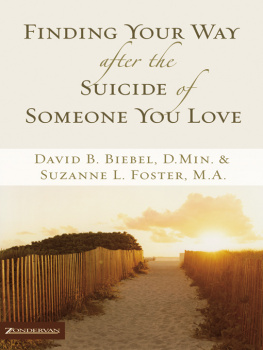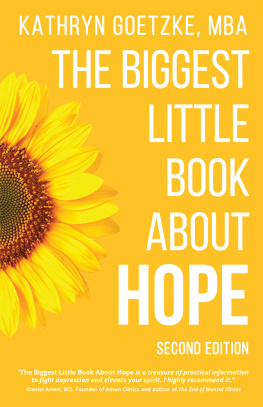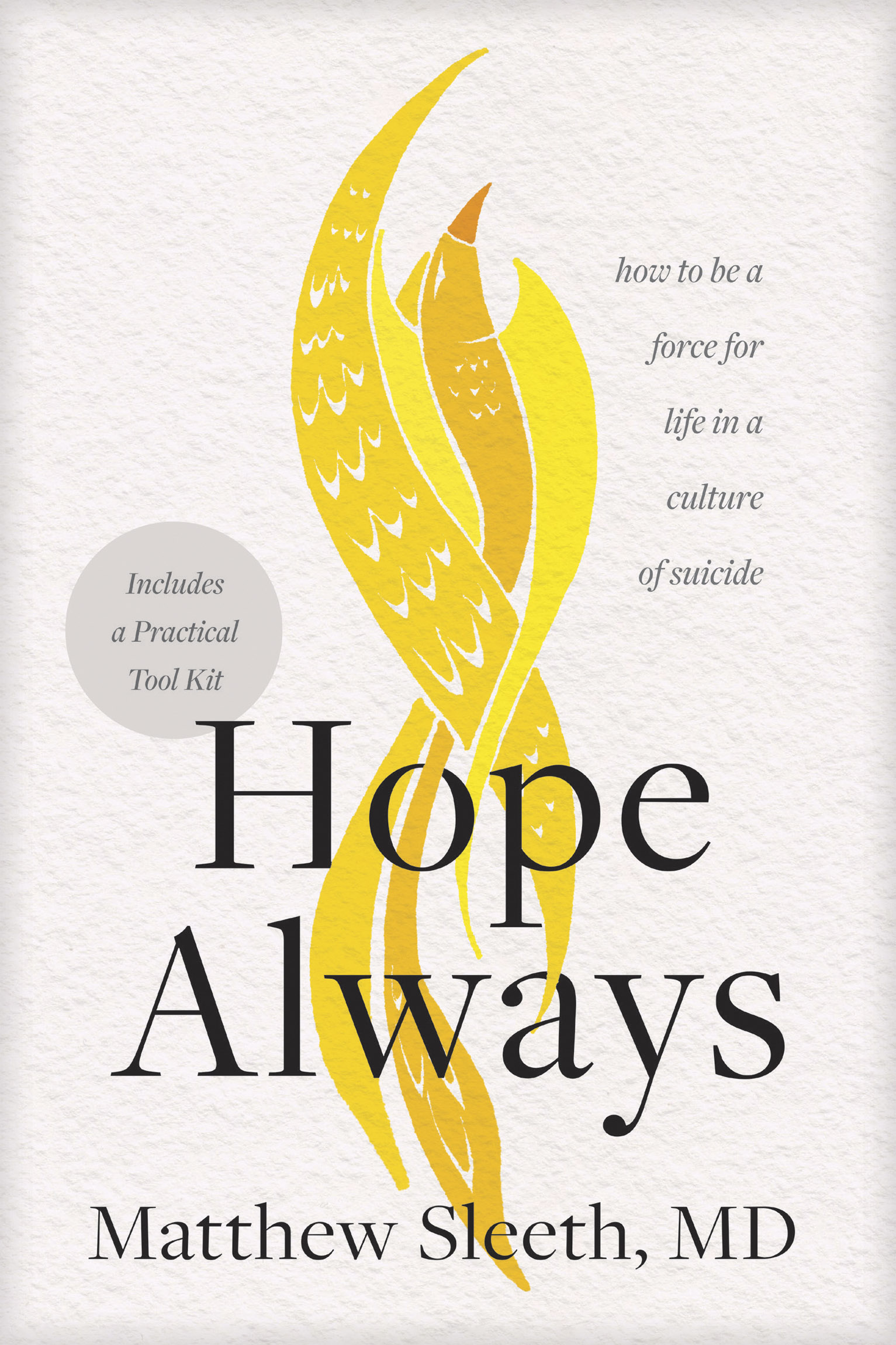
Hope is the thing with feathers that
perches in the soul and sings the tune without the wordsAnd never stops at all.
EMILY DICKINSON

Visit Tyndale online at tyndale.com.
Visit Tyndale Momentum online at tyndalemomentum.com.
TYNDALE, Tyndales quill logo, Tyndale Momentum, and the Tyndale Momentum logo are registered trademarks of Tyndale House Ministries. Tyndale Momentum is the nonfiction imprint of Tyndale House Publishers, Carol Stream, Illinois.
Hope Always: How to Be a Force for Life in a Culture of Suicide
Copyright 2021 by Matthew Sleeth. All rights reserved.
Cover illustration of flame by Lindsey Bergsma. Copyright Tyndale House Ministries. All rights reserved.
Designed by Lindsey Bergsma
Published in association with Don Gates of the literary agency The Gates Group; www.the-gates-group.com.
Unless otherwise indicated, all Scripture quotations are taken from the Holy Bible, New Living Translation, copyright 1996, 2004, 2015 by Tyndale House Foundation. Used by permission of Tyndale House Publishers, Carol Stream, Illinois 60188. All rights reserved.
Scripture quotations marked ESV are from The ESV Bible (The Holy Bible, English Standard Version), copyright 2001 by Crossway, a publishing ministry of Good News Publishers. Used by permission. All rights reserved.
Scripture quotations marked KJV are taken from the Holy Bible, King James Version.
Scripture quotations marked NIV are taken from the Holy Bible, New International Version, NIV. Copyright 1973, 1978, 1984, 2011 by Biblica, Inc. Used by permission. All rights reserved worldwide.
For information about special discounts for bulk purchases, please contact Tyndale House Publishers at , or call 1-855-277-9400.
ISBN 978-1-4964-5001-2
Build: 2021-04-21 15:13:51 EPUB 3.0

To you who struggle and struggled and endure
Bearing a cross upon your shoulders,
The weight known only to God;
We who love and have loved you,
Salute you,
And cry tears of thanks that God
Has given you the strength and courage to see
Another day.
Our prayer:
That you walk with Gods face upon you,
Stepping out of cast shadows,
Into his light,
And that you hope,
Always and forever.
Amen and amen.

Introduction
Everything that is done in the world is done by hope.
MARTIN LUTHER
C ERTAIN OBJECTS around my house are haunted. The brass pen from my sister Naomi. The ceramic vase made by Carol that sits on my desk. The beautiful quarter-sawn oak kitchen that our cabinetmaker Josh struggled to get just right. Even the wedding portrait of Nancy and me taken forty years ago, with Mark standing by my side.
These objects have a sadness about them, but not just because the people who gave or made them are gone. At my age Ive lost many friends. No, some deaths are tougher to get beyond than others. Some haunt you. Its the manner in which the people died that makes moving on so hard.
Two years ago, my sister said she was going to kill herself. She disappeared in Eastern Europe, and emails asking if she is alive go unanswered and unanswered. Last spring, shortly after installing our kitchen, Josh hanged himself. Mark, the best man in my wedding, and Carol, my childhood friend, both shot themselves.
Sad and painful stories like these are familiar to almost everyone. This coming year, over a hundred thousand Americans will die by their own hand. Some will be classified as accidental overdoses, others as intentional suicides. Whether by intention or accident, for these people America was not a place of life, liberty, and the pursuit of happiness. Instead, it was a landscape of depression, addiction, loneliness, pain, frustration, andin the endpremature death.
What should we do? Mental health experts say we need more counselors. Doctors say we need more medicines. Teachers say we need more education. There is something to be said for each of these recommendations, but what if the men and women suffering from depression are really just the sensitive ones among us? What if they are our canary in the coal mine? What if weve built a world that is unlivable?
Hope Always is a guide for people who currently deal with, have dealt with, or will deal with suicide. It is for people who are struggling with suicidal ideation and the friends, family, colleagues, and church leaders who love them.
At its core, this book is both an argument for life and a plan for preventing suicide. Throughout these pages, I will offer you a perspective not typically found in books about suicide. Here we will focus on why people did not commit suicide rather than on why they did. We will also examine the limitations of statistics and dig deeply into the role of faith in preventing suicide.
If you have lost someone to suicide, my heart aches for you. And while I hope you will find comfort and answers here, this book is not primarily about easing your pain. Rather, this book is written in an attempt to keep others from hurting in the way you do now. It is about preventing suicide. Suicide is a disease for which prevention is the only acceptable treatment.
I am intensely interested in what keeps people alive. Too often, however, when looking for solutions we turn to those who have failed. When I wrote my first book years ago, I cited the case of the two most popular books on marriage at the time. The author of the most popular book had been married five times and was the third spouse of the author of the second most popular marriage book. Although it is possible to learn from others mistakes, we should also heed Jesus warning about the dangers of the blind leading the blind.
The beliefs and thoughts expressed in this book flow from two ancient historic streams. First, I write as a Western, scientifically trained physician in the tradition of those who have been taking an oath since the fifth century BC to first, do no harm. Throughout my career as an ER doctor and chief of the hospital medical staff, I asked hundreds of people, Are you thinking about harming yourself? I committed scores of patients against their will. I pumped stomachs, intubated, and dialyzed, trying to give my patients another shot at life.
Second, my writing rests on an ardent belief in and personal relationship with the Lord Jesus Christ. Throughout the majority of my medical career as I fought to prevent suicide, I was an atheist. At age 47, I met the Lord. Fortunately, the ethics about suicide contained in the Hippocratic oath are in complete agreement with the theologies of both Judaism and Christianity. When I became a Christian, my beliefs about many things changed. However, instead of abandoning my medical beliefs about preventing suicide, I found them firmly undergirded by my new faith. They now rest on a thousands-year-old theological foundation of bedrock.
Since becoming a Christian, I have focused on a different kind of healing than I practiced as a doctor. In chapels, churches, universities, and homes across the country, Ive been friend and minister to those who have heard the voice of demons beckoning them into eternal night. Homer once described their haunting song as one sung by Sirens. Have you heard it? Do you know someone who has? Although suicide is rarely addressed from the pulpit, you are far from alone. Youth leaders and elders, pastors and priests, seminary presidents and Sunday school teachersno one is left untouched by our suicide crisis.


